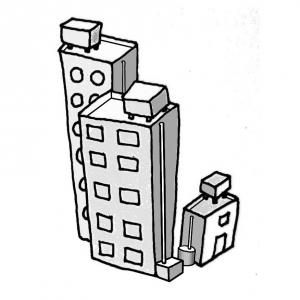Rooftop rainwater harvesting (RTRWH) is the most common technique of rainwater harvesting (RWH) for domestic consumption. It can be done easily, doesn’t cost much and is applicable at small-scale with a minimum of specific expertise or knowledge; or in more sophisticated systems at large-scale (e.g. a whole housing area). Rainwater is collected on the roof and transported with gutters to a storage reservoir, where it is either used for groundwater recharge or provides water at the point of consumption. Rainwater harvesting can supplement water sources when they become scarce or are of low quality like brackish groundwater or polluted surface water in the rainy season. However, rainwater quality may be affected by air pollution, animal or bird droppings, insects, dirt and organic matter. Therefore regular maintenance (cleaning, repairs, etc.) as well as a treatment before water consumption (e.g. filtration or/and disinfection) are very important.
| In | Out |
|---|---|
Freschwater, Drinking Water |
Rainwater harvesting (RWH) is a simple technique that offers many benefits. It can be done very low-tech, doesn’t cost much and is applicable at small-scale with a minimum of specific expertise or knowledge; or in more sophisticated systems at large-scale (e.g. a whole housing area).The most common technique in urban areas (besides storm water management) is rooftop rainwater harvesting: rainwater is collected on the roof and transported with gutters to a storage reservoir, where it provides water at the point of consumption or is used for groundwater recharge (see also surface and subsurface artificial groundwater recharge). Collected rainwater can supplement other water sources when they become scarce or are of low quality like brackish groundwater or polluted surface water in the rainy season. It also provides a good alternative and replacement in times of drought or when the water table drops and wells go dry. The technology is flexible and adaptable to a very wide variety of conditions. It is used in the richest and the poorest societies, as well as in the wettest and the driest regions on our planet (HATUM & WORM 2006).
Each rainwater harvesting system consists of at least the following components (INFONET-BIOVISION 2010):
- Rainfall
- A catchment area or roof surface to collect rainwater.
- Delivery systems (gutters) to transport the water from the roof or collection surface to the storage reservoir.
- Storage reservoirs or tanks to store the water until it is used.
- An extraction device (depending on the location of the tank - may be a tap, rope and bucket, or a pump (HATUM & WORM 2006); or a infiltration device in the case the collected water is used for well or groundwater recharge (see also surface or subsurface artificial groundwater recharge)
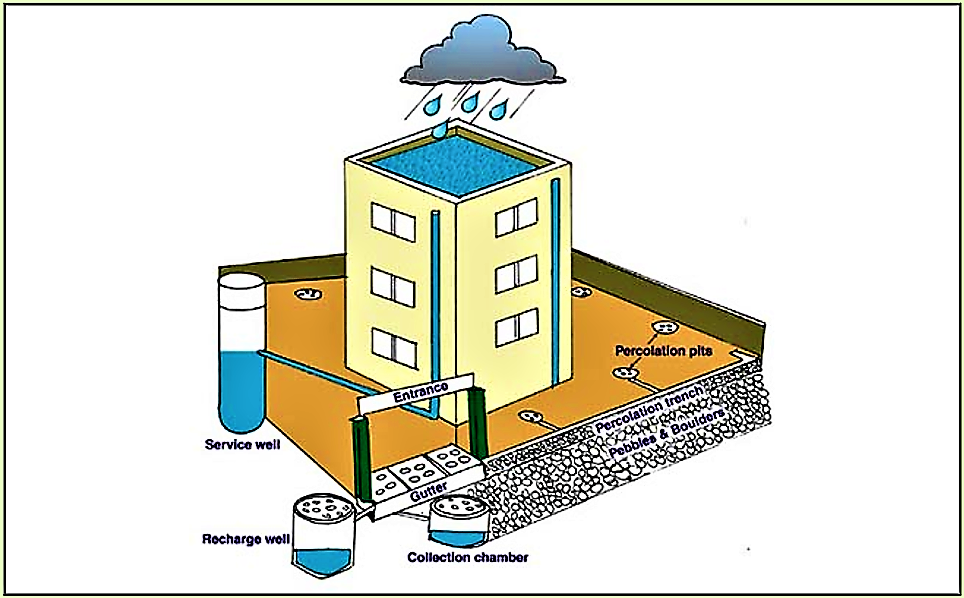
Additionally there are a wide variety of systems available for treating water either before, during and/or after storage (e.g. biosand filter, SODIS, chlorination; or in general HWTS).

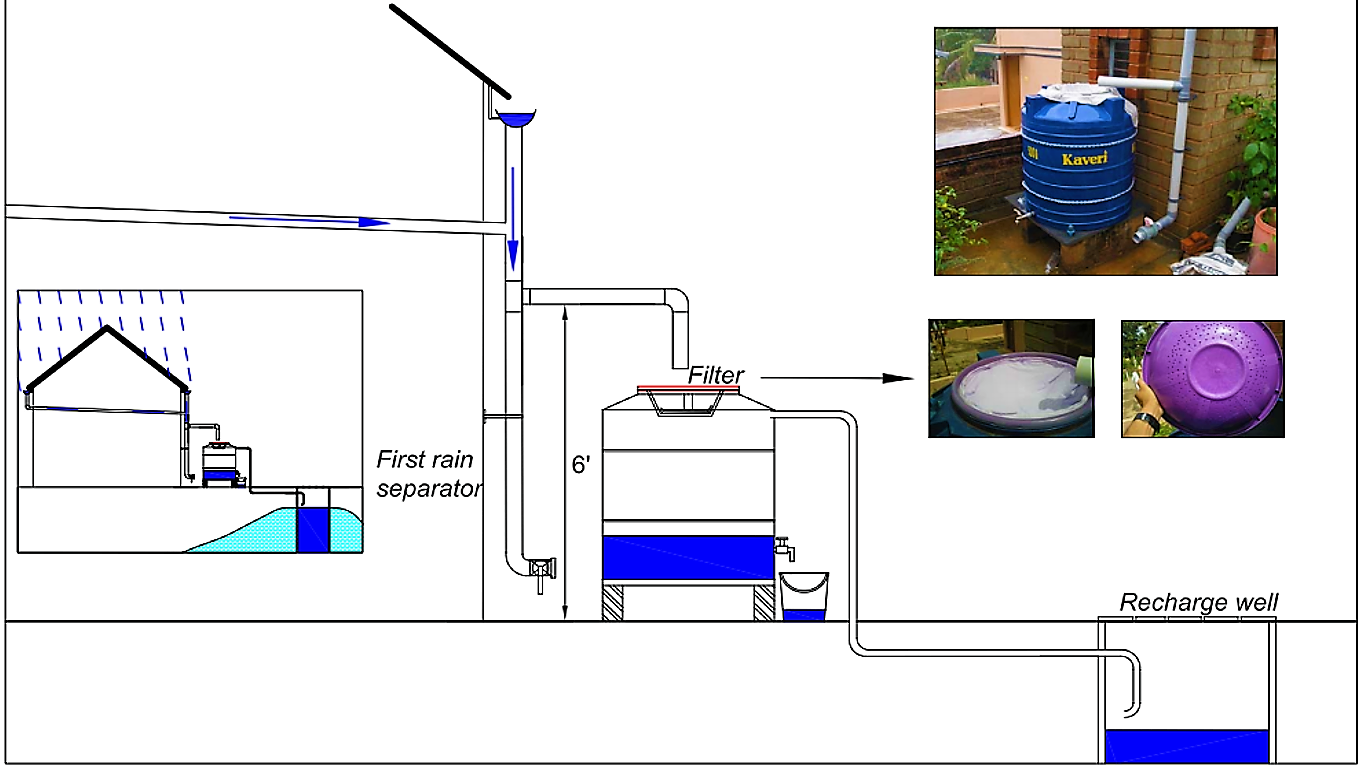
The rainfall pattern over the year plays a key role in determining whether RWH can compete with other water supply systems. Tropical climates with short (one to four month) dry seasons and multiple high-intensity rainstorms provide the most suitable conditions for water harvesting. In addition, rainwater harvesting may also be valuable in wet tropical climates (e.g. Bangladesh), where the water quality of surface water may vary greatly throughout the year. As a general rule, rainfall should be over 50 mm/month for at least half a year or 300 mm/year (unless other sources are extremely scarce) to make RWH environmentally feasible (HATUM & WORM 2006). In the following table, some examples are given for annual rainfall in different regions (HATUM & WORM 2006).

To be ‘suitable’ the roof should be made of some hard material that does not absorb the rain or pollute the run-off. Thus, tiles, metal sheets and most plastics are suitable, while grass and palm-leaf roofs are generally not suitable (THOMAS & MARTINSON 2007).
The delivery system from rural rooftop catchment usually consists of gutters hanging from the sides of the roof sloping towards a down pipe and tank. Guttering is used to transport rainwater from the roof to the storage vessel. Guttering comes in a wide variety of shapes and forms, ranging from the factory made PVC type similar as the pipes used in water distribution systems) to home made guttering using bamboo or folded metal sheet. Guttering is usually fixed to the building just below the roof and catches the water as it falls from the roof (HATUM & WORM 2006).
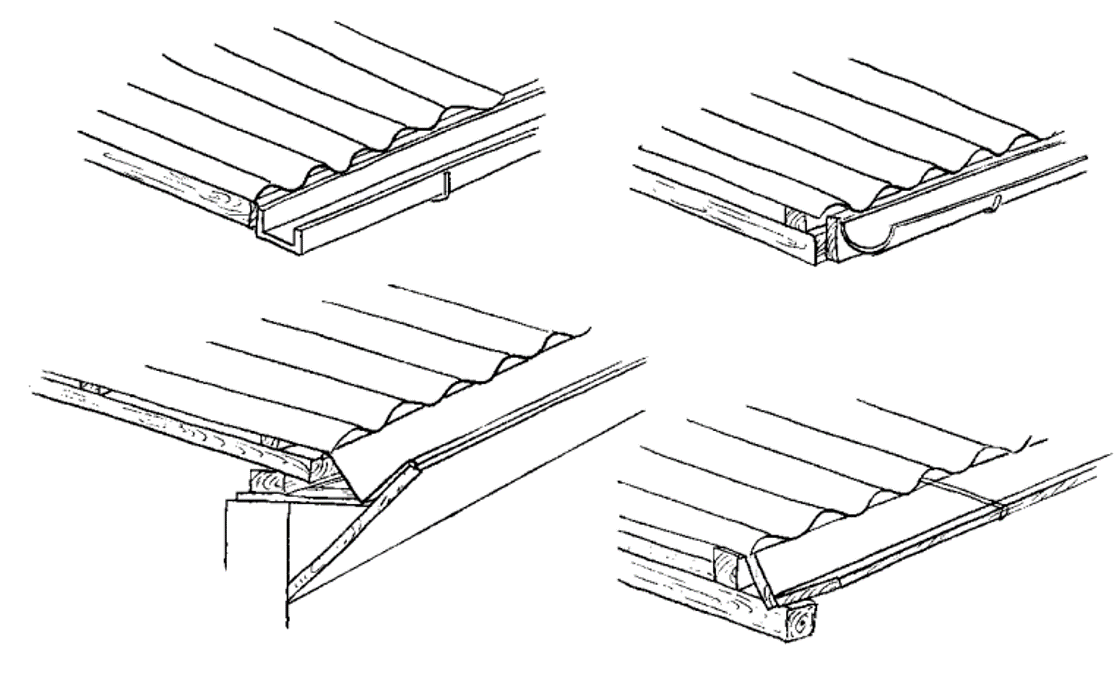
Debris, dirt, dust and droppings will collect on the roof of a building or other collection area. When the first rains arrive, this unwanted matter would be washed into the tank. This will cause contamination of the water and the quality will be reduced. Many RWH systems therefore incorporate a system for diverting this ‘first flush’ water so that it does not enter the tank. These systems are called first flush devices. Further information on first flush devices is provided in DOLMAN & LUNDQUIST (2008) and PRACTICAL ACTION (2008).
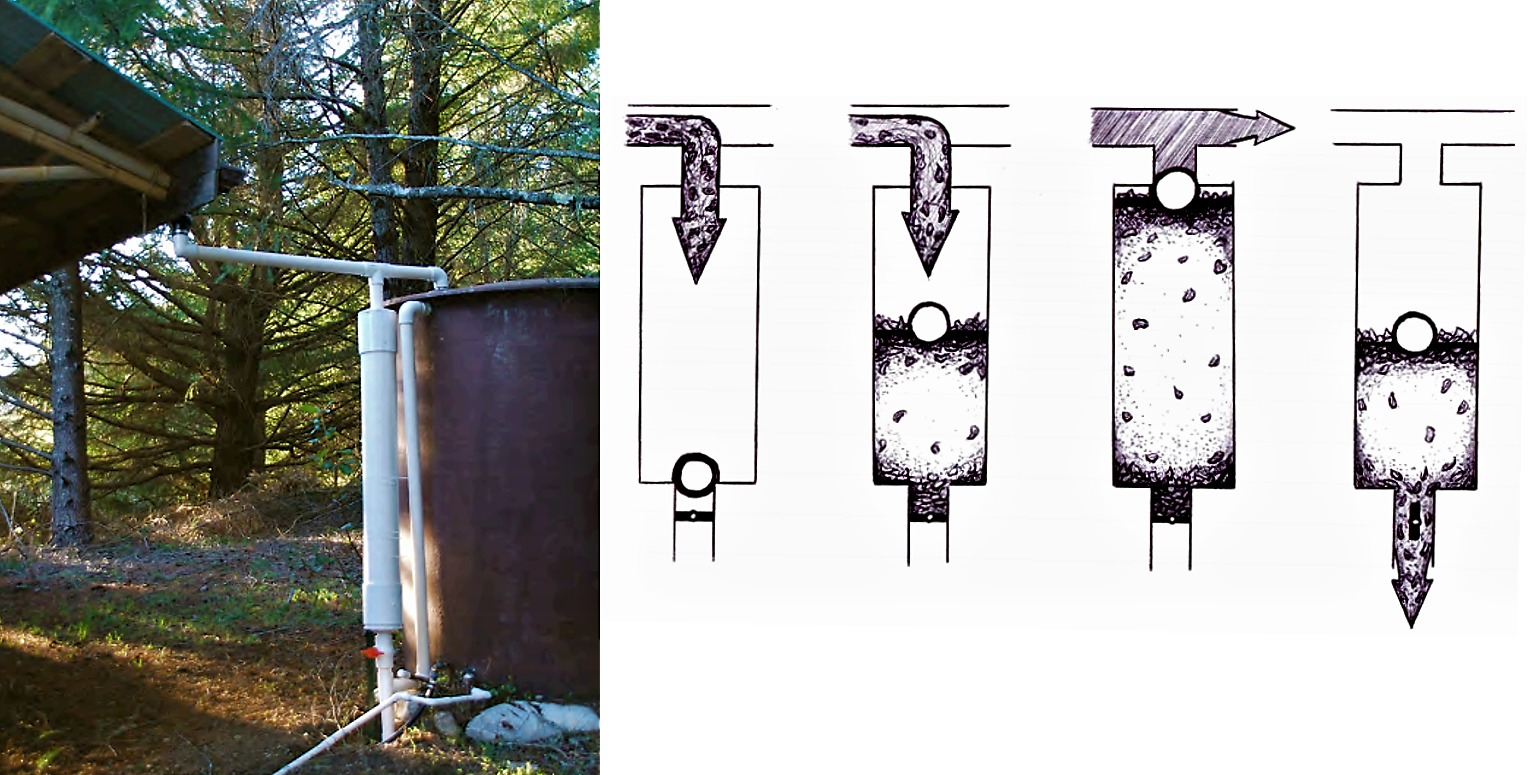
The simpler ideas are based on a manually operated arrangement whereby the inlet pipe is moved away from the tank inlet and then replaced again once the initial first flush has been diverted. This method has obvious drawbacks in that there has to be a person present who will remember to move the pipe. Other, more sophisticated methods provide a much more elegant means of rejecting the first flush water, (described in PRACTICAL ACTION (2008), training material). But practitioners often recommend that very simple, easily maintained systems be used, as these are more likely to be repaired if failure occurs (PRACTICAL ACTION 2008).
A coarse filter, preferably made of nylon or a fine mesh, can also be used to remove dirt and debris before the water enters the tank (HATUM & WORM 2006).
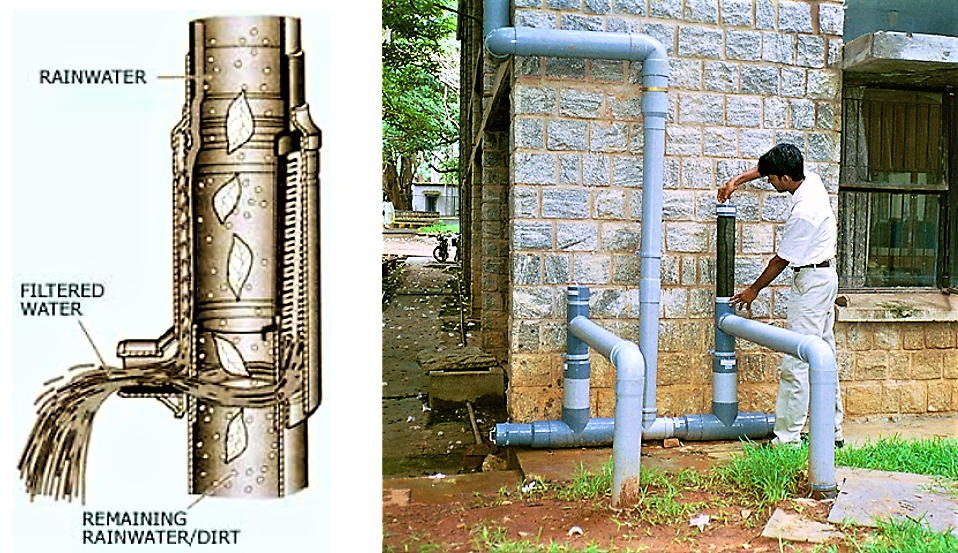
There are almost unlimited options for storing rainwater. Common vessels used for very small-scale water storage in developing countries include plastic bowls and buckets, jerry cans, clay or ceramic jars, cement jars, old oil drums, empty food containers, etc. For storing larger quantities of water, the system will usually require a tank above or below ground. These can vary in size from a cubic metre (1000 litres) up to hundreds of cubic metres for large projects (PRACTICAL ACTION 2008). For domestic systems volumes are typically up to a maximum of 20 or 30 cubic metres (PRACTICAL ACTION 2008). Surface tanks are most common for roof collection. Materials for surface tanks include metal, wood, plastic, fibreglass, brick, inter-locking blocks, compressed soil or rubble-stone blocks, ferro-cement and reinforced concrete. The choice of material depends on local availability and affordability. The material and design for the walls of sub-surface tanks or cisterns must be able to resist the soil and soil water pressures from outside when the tank is empty. Tree roots can damage the structure below ground. Careful location of the tank is therefore important (HATUM & WORM 2006).
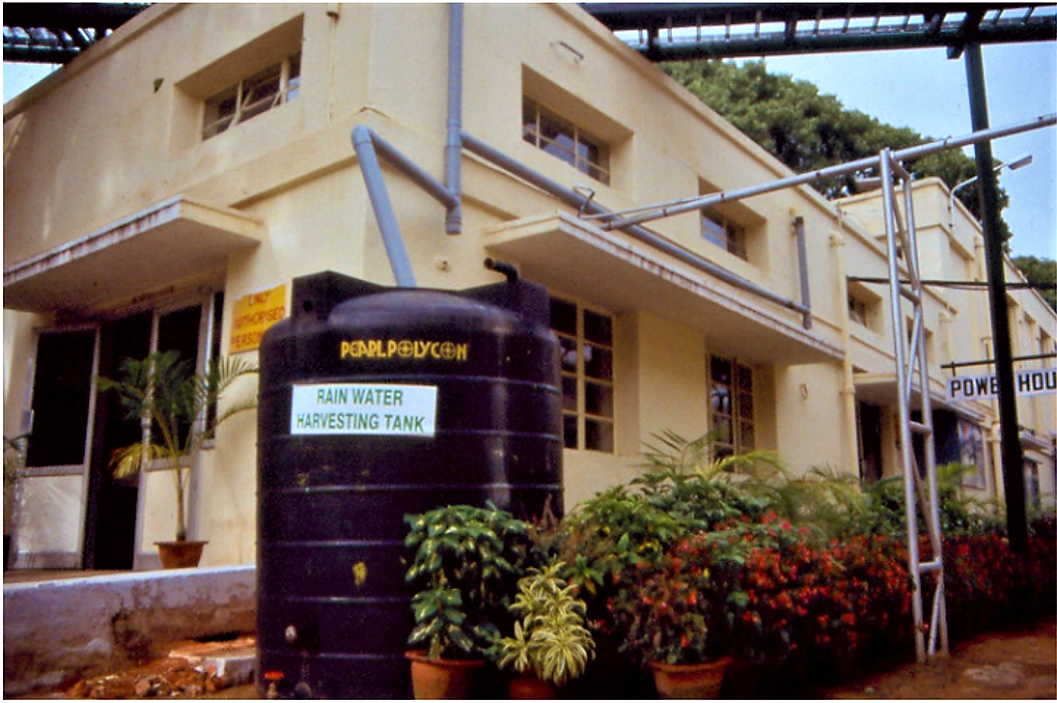
There are a number of different methods used for sizing the tank. These methods vary in complexity and sophistication. PRACTICAL ACTION (2008) gives an overview over three different methods. Some are readily carried out by relatively inexperienced, first-time practitioners, while others require computer software and trained engineers who understand how to use this software. The storage requirement will be determined by a number of interrelated factors, which include: local rainfall data and weather patterns, size of roof, runoff coefficient (depending on roof material and slope) and user numbers and consumption rates.
In reality the cost of the tank materials will often govern the choice of tank size. In other cases, such as large RWH programmes, standard sizes of tank are used regardless of consumption patterns, roof size or number of individual users (although the tank size will, hopefully, be based on local averages) (PRACTICAL ACTION 2008).
Collected water can also be used for replenishing a well or the aquifer (see also surface or subsurface artificial groundwater recharge). In a case study of SHRESTHA (2010), excess rainwater during the rainy season is used to recharge a dug well, as well as the groundwater. In this case recharging the groundwater even improved the water quality in the dug well.
Depending on the user behaviour the storage and treatment (water quality) infrastructure is probably different. In some parts of the world, RWH is only used to collect enough water during a storm to save a trip or two to the main water source (open well or pump). In this case only a small storage container is required. In arid areas, however, people strive to create sufficient catchment surface area and storage capacity to provide enough water to meet all the needs of the users (HATUM & WORM 2006).
Four types of user regimes can be discerned:
Occasional - Water is stored for only a few days in a small container. This is suitable when there is a uniform rainfall pattern and very few days without rain and there is a reliable alternative water source nearby.
Intermittent - There is one long rainy season when all water demands are met by rainwater, however, during the dry season water is collected from non-rainwater sources. RWH can then be used to bridge the dry period with the stored water when other sources are dry.
Partial - Rainwater is used throughout the year but the ‘harvest’ is not sufficient for all domestic demands. For instance, rainwater is used for drinking and cooking, while for other domestic uses (e.g. bathing and laundry) water from other sources is used.
Full - Only rainwater is used throughout the year for all domestic purposes. In such cases, there is usually no alternative water source other than rainwater, and the available water should be well managed, with enough storage capacity to bridge the dry period.
Run-off from a roof can be directed with little more than a split pipe or piece of bamboo into an old oil drum (provided that it is clean) placed near the roof. The water storage tank or reservoir usually represents the biggest capital investment element of small-scale rooftop urban rainwater harvesting system and therefore require careful design to provide optimal storage capacity while keeping the cost as low as possible. Installing a water harvesting system at household level can cost anywhere from USD 100 up to USD 1000. It is difficult to make an exact estimate of cost because it varies widely depending on the availability of existing structures, like rooftop surface, pipes and tanks and other materials that can be modified for a water harvesting structure. Expensive systems with large tanks deliver more water than cheaper systems with small tanks (THOMAS & MARTINSON 2007).
Rainwater itself is of excellent quality, only surpassed by distilled water – it has very little contamination, even in urban or industrial areas, so it is clear, soft and tastes good. Contaminants can however be introduced into the system after the water has fallen onto a surface (THOMAS & MARTINSON 2007).
Firstly, there is the issue of bacteriological water quality. Rainwater can become contaminated by pathogenic bacteria (e.g. form animal or human faeces) entering the tank from the catchment area. It is advised that the catchment surface always be kept very clean. Rainwater tanks should be designed to protect the water from contamination by leaves, dust, insects, vermin, and other industrial or agricultural pollutants. Tanks should be sited away from trees, with good fitting lids and kept in good condition. Incoming water should be filtered or screened, or allowed to settle to take out foreign matter. Water, which is relatively clean on entry to the tank, will usually improve in quality if allowed to sit for some time inside the tank. Bacteria entering the tank will die off rapidly if the water is relatively clean. Algae will grow inside a tank if sufficient sunlight is available for photosynthesis. Keeping a tank dark and sited in a shady spot will prevent algae growth and also keep the water cool. As mentioned above, first flush devices help to prevent the dirty ‘first flush’ water from entering the storage tank. The area surrounding a RWH should be kept in good sanitary condition, fenced off to prevent animals fouling the area or children playing around the tank. Any pools of water gathering around the tank should be drained and filled (PRACTICAL ACTION 2008).
Secondly, there is a need to prevent insect vectors from breeding inside the tank. In areas where malaria is present, providing water tanks without any care for preventing insect breeding can cause more problems than it solves. All tanks should be sealed to prevent insects from entering. Mosquito proof screens should be fitted to all openings (PRACTICAL ACTION 2008).
| Working principle | Rainwater collected on the rooftop is transported with gutters to a storage reservoir. There is a wide variety of systems available for RWH systems as well as for treating water before, during and after storage, which helps to prevent water from contamination. |
| Capacity/adequacy | The supply is limited by the amount of rainfall and the size of the catchment area and storage reservoir (HATUM & WORM 2006). Storage reservoirs can vary in size from a cubic metre up to hundreds of cubic metres for large projects, but typically up to a maximum of 20 or 30 cubic metres for a domestic system (PRACTICAL ACTION 2008). |
| Performance | Rainwater is generally better quality than other available or traditional water sources (groundwater may be unusable due to fluoride, salinity or arsenic; HATUM & WORM 2006). |
| Costs | 100 to 1000 USD depending on material, storage size and technology. |
| Self-help compatibility | Depending on the scale, construction of RWH systems can be very simple and local people can easily be trained to build these themselves. This reduces costs and encourages more participation, ownership and sustainability at community level (HATUM & WORM 2006). |
| O&M | Proper operation and regular maintenance is a very important factor that is often neglected. Regular inspection, cleaning, and occasional repairs are essential for the success of a system (HATUM & WORM 2006). |
| Reliability | If well constructed and maintained drinking water in good quality is available. |
| Main strength | It provides water, which otherwise would have been lost, at the point of consumption (HATUM & WORM 2006). |
| Main weakness | Limited supply: The supply is limited by the amount of rainfall and the size of the catchment area and storage reservoir (HATUM & WORM 2006). |
RTRWH in urban areas can be implemented everywhere from a single household to community level (SHRESTHA 2010): the technology is flexible and adaptable to a very wide variety of conditions. It is used in the richest and the poorest societies, as well as in the wettest and the driest regions on our planet. Collected rainwater can supplement other water sources when they become scarce or are of low quality like brackish groundwater or polluted surface water in the rainy season. It also provides a good alternative and replacement in times of drought or when the water table drops and wells go dry. (HATUM & WORM 2006).
Rooftop Rainwater Harvesting System
Filters developed by WISY
Rainwater Harvesting for Domestic Use
This booklet explains how to collect, store and purify rainwater for direct use at household level. It is a practical guide to creating a rainwater harvesting infrastructure from design to implementation that is illustrated with pictures, tables and examples.
HATUM, T. WORM, J. (2006): Rainwater Harvesting for Domestic Use. Wageningen: Agrosima and CTA URL [Accessed: 12.03.2019] PDFRainwater Harvesting Filter – “PopUp Filter” – Karnataka
Rainwater Harvesting: Rain barrel
Eco Home for Sustainable Water Management- A Case Study in Kathmandu
This paper describes a case study of a house in Kathmandu where rainwater is used for all purposes including drinking, greywater is recycled for non drinkable purposes and human excreta is utilized as a fertilizer by adopting ecological sanitation technique.
SHRESTHA, R.R. (2010): Eco Home for Sustainable Water Management- A Case Study in Kathmandu. Kathmandu: United Nation Development Program (UNDP) URL [Accessed: 12.03.2019] PDFRoofwater Harvesting: A Handbook for Practitioners
This handbook has been written to assist NGO and government staff responsible for implementing domestic roofwater harvesting systems or programmes. It can be used to design single roofwater harvesting systems. The handbook focuses primarily on low-cost DRWH in the ‘humid tropics’ (areas close to the Equator with average rainfall over 800 mm).
THOMAS, T.H. MARTINSON, D.B. (2007): Roofwater Harvesting: A Handbook for Practitioners. Delft: IRC International Water and Sanitation Centre URL [Accessed: 12.03.2019] PDFNepal’s Experiences in Community-Based Water Resource Management
This paper documents WAN and its partners’ work on community-based approaches to water resource management, and attempts to distil important lessons from their experience to inform continued refinement of WAN’s institutional approach to CWRM and inform sector learning.
WAN (2008): Nepal’s Experiences in Community-Based Water Resource Management. (= Fieldwork paper ). Water Aid Nepal (WAN) and End Water Poverty URL [Accessed: 30.03.2010] PDFSWITCH in the City: Putting Urban Water Management to the Test
This book brings together findings from activities in urban water management in 12 cities that each involved multiple consortium partners and many city stakeholders. The approach was specifically to encourage stakeholder engagement, and these chapters reflect the inputs of many city actors and researchers who contributed to the activities.
BUTTERWORTH, J. MCINTYRE, P. SILVA WELLS, C. WHITE, C. (2011): SWITCH in the City: Putting Urban Water Management to the Test. The Hague: International Water and Sanitation Centre (IRC) URL [Accessed: 04.04.2019] PDFRainwater Harvesting for Natural Resources Management; A planning Guide for Tanzania
A planning handbook that provides planners with practical tips on how rainwater harvesting can form an integrated part of district development efforts. The book also gives practical guidelines in the planning steps required to incorporate rainwater harvesting in development plans, and shows how to implement them in the farmers’ context.
HATIBU, N. MAHOO, H.F. (2000): Rainwater Harvesting for Natural Resources Management; A planning Guide for Tanzania . Stockholm: Sida's Regional Land Management Unit URL [Accessed: 29.02.2012] PDFThe Private Sector and Rainwater Harvesting
This newsletter introduces a few of IRHA's private sector members and their products and implementation experiences. It contains also an introduction to Rain Harvesting’s complete system of products for rainwater collection.
IRHA (2013): The Private Sector and Rainwater Harvesting. (= IRHA newsletter , 50 ). Geneva: International Rainwater Harvesting Alliance PDFRainwater Harvesting and Utilisation: An Environmentally Sound Approach for Sustainable Urban Water Management: An Introductory Guide for Decision-Makers
This document serves as guide for decision-makers. It explains the importance of rainwater harvesting in urban areas and includes examples and technology description.
GDRC (2002): Rainwater Harvesting and Utilisation: An Environmentally Sound Approach for Sustainable Urban Water Management: An Introductory Guide for Decision-Makers. Kobe: Global Development Research Centre (GDRC) URL [Accessed: 14.03.2011] PDFSmart Water Harvesting Solutions
This booklet on smart water harvesting describes a number of creative solutions in situations where there seems to be no water. It shows practical efforts to "create water", especially in drought prone areas. It does not limit itself to the act of harvesting, but includes capturing water during periods of rain, so that it is available for periods of drought. The book is an effective source of inspiration for local communities, civil engineers, NGOs, research institutes, donors and governments.
NWP (2007): Smart Water Harvesting Solutions . Examples of innovative low-cost technologies for rain, fog, runoff water and groundwater. (= Smart water solutions ). Amsterdam: KIT Publishers URL [Accessed: 12.03.2019] PDFSmall Community Water Supplies: Technology, People and Partnership: Rain Water Harvesting - Chapter 7
This book provides a general introduction to a wide range of technologies. Among the topics covered are: planning and management of small water supplies, community water supplies in Central and Eastern European countries, water quality and quantity, integrated water resources management, artificial recharge, rainwater harvesting, spring water tapping, groundwater withdrawal, water lifting, surface water intake, water treatment, aeration, coagulation and flocculation, sedimentation, multi-stage filtration, desalination technology, disinfection, household level water treatment, technologies for arsenic and iron removal from ground water, and emergency and disaster water supply. Chapter 7: Rain Water Harvesting
SMET, J. ; WIJK, C. van (2002): Small Community Water Supplies: Technology, People and Partnership: Rain Water Harvesting - Chapter 7. The Hague: International Water and Sanitation Centre (IRC) URL [Accessed: 12.03.2019] PDFRainwater Harvesting and Utilisation. Blue Drop Series, Book 2: Beneficiaries & Capacity
The Blue Drop Series on Water Harvesting and Utilisation is divided into three and each one has a specific target group- policy makers, beneficiaries and capacity and implementing agencies. The publications give an overview of the concept of rainwater and have a focus on the legal and administrative framework for rainwater harvesting. Book 2: Beneficiaries & Capacity.
UN-HABITAT (2005): Rainwater Harvesting and Utilisation. Blue Drop Series, Book 2: Beneficiaries & Capacity. Nairobi: UN-Habitat URL [Accessed: 12.03.2019] PDFRainwater Harvesting and Utilisation. Blue Drop Series, Book 3: Beneficiaries & Capacity. Nairobi: UN-Habitat.
The Blue Drop Series on Water Harvesting and Utilisation is divided into three and each one has a specific target group- policy makers, beneficiaries and capacity and implementing agencies. The publications give an overview of the concept of rainwater and have a focus on the legal and administrative framework for rainwater harvesting. Book 3: Project Managers and Implementing Agencies.
UN-HABITAT (2005): Rainwater Harvesting and Utilisation. Blue Drop Series, Book 3: Beneficiaries & Capacity. Nairobi: UN-Habitat. . UN-Habitat URL [Accessed: 12.03.2019] PDFSource Book of Alternative Technologies for Freshwater Augmentation in Latin America and the Caribbean
The Latin American and Caribbean countries have seen growing pressure on water resources, with increasing demand and costs, for agricultural, domestic and industrial consumption. This has brought about the need to maximize and augment the use of existing or unexploited sources of freshwater. There are many modern and traditional alternative technologies for improving the utility and augmenting the supply of water being employed in various countries, but with limited application elsewhere due to the lack of information transfer among water resources managers and planners. This book was prepared to provide water resource managers and planners, especially in developing countries and in countries with economies in transition, with information on the range of technologies that have been developed and used in the various countries throughout the world.
UNEP (1998): Source Book of Alternative Technologies for Freshwater Augmentation in Latin America and the Caribbean. Nairobi: United Nations Environment Programme (UNEP) URL [Accessed: 17.10.2011]Water Harvesting
Water harvesting has been practiced successfully for millennia in parts of the world – and some recent interventions have also had significant local impact. Yet water harvesting’s potential remains largely unknown, unacknowledged and unappreciated. These guidelines cover a wide span of technologies from large-scale floodwater spreading to practices that collect and store water from household compounds.
MEKDASCHI STUDER, R. LINIGER, H. (2013): Water Harvesting. Guidelines to Good Practice. Bern/Amsterdam/Wageningen/Rome: Centre for Development and Environment (CDE), Rainwater Harvesting Implementation Network (RAIN), MetaMeta, The International Fund for Agricultural Development (IFAD) URL [Accessed: 12.03.2019] PDFRooftop Rainwater Harvesting for tackling Fluoride contaminated Ground Water
Karnataka, a state of India, has fluoride-contaminated groundwater. This document discusses RTRWH as a possible strategy to tackle potable water shortages.
RAINWATERCLUB (n.y): Rooftop Rainwater Harvesting for tackling Fluoride contaminated Ground Water. Bangalore: RAINWATERCLUB URL [Accessed: 11.03.2011] PDFEco Home for Sustainable Water Management- A Case Study in Kathmandu
This paper describes a case study of a house in Kathmandu where rainwater is used for all purposes including drinking, greywater is recycled for non drinkable purposes and human excreta is utilized as a fertilizer by adopting ecological sanitation technique.
SHRESTHA, R.R. (2010): Eco Home for Sustainable Water Management- A Case Study in Kathmandu. Kathmandu: United Nation Development Program (UNDP) URL [Accessed: 12.03.2019] PDFWater Security Measure for Future Sustainability - Rainwater Harvesting
This document gives a short introduction on water scarcity in India, briefly presents RTRWH technology and discusses the water quality of RWH in a case study.
THAKUR, P. (n.y): Water Security Measure for Future Sustainability - Rainwater Harvesting. Pune: Ecosan Services Foundation PDFGreywater
This Sustainable Sanitation Practice (SSP) issue contains the following contributions: 1. Combined Greywater Reuse and Rainwater Harvesting in an Office Building - Austria, 2. Household Greywater Treatment for Peri-Urban Areas - Kenya, 3. Greywater Use in Peri-Urban Households - Uganda, 4. Greywater Treatment in Apartment Building - Austria, 5. Combined Greywater Treatment Using a Membrane Bioreactor.
MUELLEGGER, E. ; LANGEGRABER, G. ; LECHNER, M. (2009): Greywater . Treatment and Reuse. (= Sustainable Sanitation Practice , 1 ). Vienna: Ecosan Club URL [Accessed: 01.07.2013] PDFCaribbean Rainwater Harvesting Handbook
This handbook serves as a practical guideline featuring best practice for RWH in small island Caribbean environments. It covers the most important topics on RTRWH using helpful illustrations and pictures.
CEHI (2009): Caribbean Rainwater Harvesting Handbook. Castries: Caribbean Environmental Health Institute (CEHI) URL [Accessed: 12.03.2019] PDFRoof Water Harvesting for a low Impact Water Supply: Featuring the Brazilian Ball Pre-Filter System: A Case Study
The following report details the components and illustrates the highlights of a first flush system called the Brazilian Ball Pre-Filter System.
DOLMAN, B. LUNDQUIST, K. (2008): Roof Water Harvesting for a low Impact Water Supply: Featuring the Brazilian Ball Pre-Filter System: A Case Study. Occidental: The WATER Institute Occidental Arts and Ecology Center (OAEC) URL [Accessed: 12.03.2019] PDFGuidance on the Use of Rainwater Tanks
This document provides general guidance on the collection, care and storage of rainwater in domestic tanks. It is written especially for the Australian state, but is adaptable for other countries too.
ENHEALTH (2004): Guidance on the Use of Rainwater Tanks. Canberra: Environmental Health Committee (enHealth) URL [Accessed: 12.03.2019] PDFRainwater Reservoirs above Ground Structures for Roof Catchment
This manual offers advice on the construction of different types of storage tanks and includes technical advice for the construction work as well as illustrative sketches.
HASSE, R. (1998): Rainwater Reservoirs above Ground Structures for Roof Catchment. Eschborn: German Agency for Technical Cooperation (GTZ) GmbH URL [Accessed: 14.03.2011] PDFWater from Roofs: A Handbook for Technicians and Builders on Survey, Design, Construction and Maintenance of Roof Catchments
This handbook contains some practical information on the application of different types and sizes of water tanks (capacity, depth, diameter and cost of construction). Graphs and photo illustrations of the water tanks make the information more comprehensive and easily understood by any reader.
NISSEN-PETERSEN, E. (2007): Water from Roofs: A Handbook for Technicians and Builders on Survey, Design, Construction and Maintenance of Roof Catchments. Nairobi: Danish International Development Assistance (Danida) URL [Accessed: 14.03.2011] PDFRoofwater Harvesting: A Handbook for Practitioners
This handbook has been written to assist NGO and government staff responsible for implementing domestic roofwater harvesting systems or programmes. It can be used to design single roofwater harvesting systems. The handbook focuses primarily on low-cost DRWH in the ‘humid tropics’ (areas close to the Equator with average rainfall over 800 mm).
THOMAS, T.H. MARTINSON, D.B. (2007): Roofwater Harvesting: A Handbook for Practitioners. Delft: IRC International Water and Sanitation Centre URL [Accessed: 12.03.2019] PDFRainwater Harvesting for Domestic Use
This booklet explains how to collect, store and purify rainwater for direct use at household level. It is a practical guide to creating a rainwater harvesting infrastructure from design to implementation that is illustrated with pictures, tables and examples.
HATUM, T. WORM, J. (2006): Rainwater Harvesting for Domestic Use. Wageningen: Agrosima and CTA URL [Accessed: 12.03.2019] PDFGreywater
This Sustainable Sanitation Practice (SSP) issue contains the following contributions: 1. Combined Greywater Reuse and Rainwater Harvesting in an Office Building - Austria, 2. Household Greywater Treatment for Peri-Urban Areas - Kenya, 3. Greywater Use in Peri-Urban Households - Uganda, 4. Greywater Treatment in Apartment Building - Austria, 5. Combined Greywater Treatment Using a Membrane Bioreactor.
MUELLEGGER, E. ; LANGEGRABER, G. ; LECHNER, M. (2009): Greywater . Treatment and Reuse. (= Sustainable Sanitation Practice , 1 ). Vienna: Ecosan Club URL [Accessed: 01.07.2013] PDFRainwater Harvesting
This website provides a brief overview on the most important topics of rainwater harvesting.
Rainwater harvesting: powerful projects and tools
This website provides a broad overview over RWH.
Rainwater harvesting: Solution to water crisis - Technology and systems
This website provides a lot of information on RWH including different technologies for rural as well as urban applications and examples from India.
Introduction to domestic roofwater harvesting
This website of the university of Warwick provides a broad range of technical manuals, case studies and general information on rainwater harvesting.
Cleaner Water - Rain Harvesting
Rainwater Harvesting is an Australian company which offers a range of products designed to collect, store and distribute higher volumes of cleaner water for all homes.
LABARONNE CITAF
LABARONNE-CITAF is a French company that offers and develops flexible bladder tanks in PVC-coated polyester fabric for storing and transporting various types of liquid. It can be used for rainwater harvesting among others.
Aqua-Aero WaterSystems (AAWS)
Aqua-Aero WaterSystems in a Dutch company that offers a set of products to purify dirty water in tropical countries. They also provide financial services such as funding and business development so that financial sustainable Water&Energy Shops can be developed
INTEWA
INTEWA is a German company that offers products for rainwater harvesting systems from small- to large-scale.
Alliance internationale pour la gestion d'eau de pluie
The video corner of the IRHA (International Rainwater Harvesting Alliance) provides, among others, videos related to rainwater harvesting.



